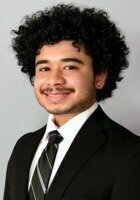All AP Biology Resources
Example Questions
Example Question #12 : Neural Anatomy
Unlike the spinal cord, the brain mainly has grey matter on the __________ and white matter on the __________.
right half . . . left half
inner layer . . . outermost layer
left half . . . right half
outermost layer . . . inner layer
outermost layer . . . inner layer
Unmyelinated nervous system components make up grey matter, while myelinated axons make up white matter. The cerebral cortex on the surface of the brain contains unmyelinated neural tissue, namely the cell bodies of neurons in the central nervous system. This region is rich in connections. Below its surface lie many myelinated axon tracts to inner nuclei, the cerebellum, other areas of the cortex, and the spinal cord.
Example Question #1841 : Ap Biology
Please complete the following statement.
The presence of __________ in the brain indicates a modification to __________.
multiple lobes. . . surface-area-to-volume ratios
the corpus callosum. . . circulation patterns
gray matter. . . sunlight exposure
folds. . . surface-area-to-volume ratios
white matter. . . electro-chemical gradients
folds. . . surface-area-to-volume ratios
Folds are present in the human brain due to the rapid evolution of brain-related tasks while the skull shape and size remained relatively constant; therefore, folds are present as modifications to limited surface-area-to-volume ratios in the skull cavity.
Example Question #1842 : Ap Biology
Which of the following is the best explanation for why we have a "blind spot?"
There are only cones in the blind spot, but no rods
There are only rods in the blind spot, but no cones
None of the choices are true
There are both rods and cones present, but they do not contain opsins
The optic nerve exits the optic disc through the blind spot
The optic nerve exits the optic disc through the blind spot
In the blind spot, there is a lack of photoreceptors as the optic nerve exits the optic disk. We normally overcome this automatically when our brains use the information of the surrounding visual field and "fills in" the blind spot.
Example Question #1 : Understand Endosymbiotic Theory
Mitochondria and chloroplasts have their own DNA, which is similar to the DNA of
fungi
protozoa
humans
bacteria
bacteria
Bacteria, a prokaryote, has circular DNA, as do mitochondria and chloroplasts. This provides support for the Endosymbiotic Theory, which states that the mitochondria and chloroplast in eukaryotic cells were once aerobic bacteria (prokaryote) that were ingested by a large anaerobic bacteria (prokaryote).
Example Question #1 : Understand Endosymbiotic Theory
Reproduction of chloroplasts and mitochondria occurs via
Fission-like process, similar to the reproduction process of bacteria
Mitosis
Meiosis
Fission-like process, similar to the reproduction process of eukaryotes
Fission-like process, similar to the reproduction process of bacteria
Chloroplasts and mitochondria reproduce through fission, the same process through which bacteria reproduce. Eukaryotes reproduce through mitosis or meiosis, depending upon the type of cell.
Example Question #105 : Cell Structures
Supporting the Endosymbiotic Theory, mitochondria and chloroplasts have a _________ membrane.
double
thin
thick
single
double
The Endosymbiotic Theory states that the mitochondria and chloroplast in eukaryotic cells were once aerobic bacteria (prokaryote) that were ingested by a large anaerobic bacteria (prokaryote). Mitochondria and chloroplasts have a double membrane (the inner membrane would have initially been the ingested prokaryote’s single membrane).
Example Question #101 : Cell Structures
Mitochondria and chloroplasts have ribosomes that are ___, similar to __ cells.
70S, eukaryotic
80S, eukaryotic
80S, prokaryotic
70 S, prokaryotic
70 S, prokaryotic
Prokaryotic cells, mitochondria, and chloroplasts have 70S ribosomes, whereas eukaryotic cells have 80S ribosomes. This provides support for the Endosymbiotic Theory, which states that the mitochondria and chloroplast in eukaryotic cells were once aerobic bacteria (prokaryote) that were ingested by a large anaerobic bacteria (prokaryote).
Example Question #111 : Cell Structures
The Endosymbiotic Theory posits that, before being engulfed by a eukaryotic cell, they were
Free-living eukaryotes
Viruses
Free-living prokaryotes
Organelles
Free-living prokaryotes
The Endosymbiotic Theory states that the mitochondria and chloroplast in eukaryotic cells were once aerobic bacteria (prokaryote) that were ingested by a large anaerobic bacteria (prokaryote). The aerobic bacteria were initially free-living prokaryotes, before being ingested by anaerobic bacteria.
Example Question #112 : Cell Structures
Which of the following is NOT evidence for the Endosymbiotic Theory?
Mitochondria and chloroplasts have 70S ribosomes
Mitochondria and chloroplasts have circular DNA
Mitochondria and chloroplasts have a double membrane
Mitochondria and chloroplasts have a single membrane
Mitochondria and chloroplasts have a single membrane
The Endosymbiotic Theory states that the mitochondria and chloroplast in eukaryotic cells were once aerobic bacteria (prokaryote) that were ingested by a large anaerobic bacteria (prokaryote). This theory explains the origin of eukaryotic cells. Numerous lines of evidence exist, including that mitochondria and chloroplasts have their own circular DNA (prokaryotes also have circular DNA), mitochondria and chloroplasts have a double membrane (the inner membrane would have initially been the ingested prokaryote’s single membrane, and the outer membrane initially would have come from the cell that engulfed it), mitochondria and chloroplasts have 70S ribosomes (prokaryotes 70S have ribosomes, whereas eukaryotes have 80S ribosomes).
Example Question #1 : Understand Types Of Signaling, Receptors, And Signaling Molecules
Which is false regarding cell signaling?
Autocrine signals bind to receptors on the same cell that released the ligand
Paracrine signals are long-lasting
Paracrine signals are used to communicate the nearby cells
Endocrine signals move via the bloodstream
Paracrine signals are long-lasting
Endocrine signals are signals from distance cells that move using the bloodstream, paracrine signals are signals used to communicate between cells in close proximity, and autocrine signals are signals that are received by the same cell in which the signal originated. Paracrine signals are signal are short-lasting, whereas endocrine signals are long-lasting.
Certified Tutor
Certified Tutor
All AP Biology Resources




